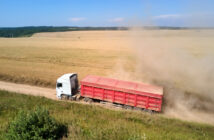The last few days have seen a rally in global grain markets. The destruction of the Kakhovka hydroelectric power plant dam and the shelling of the ammonia pipeline that transits Russian ammonia through Ukraine, have both contributed to concerns over the future of Ukrainian supplies. Russia have also said that they do not feel as though their end of the deal is being upheld, and that they are considering withdrawing from the Black Sea initiative (Ukraine export corridor deal).
So, what could the implications of the dam collapse in Ukraine, and Russia possibly pulling out of the Black Sea initiative, have on global supply next season? Also, what might that mean for prices?
Impacts of the dam destruction
Olivia Bonser, analyst Cereals and Oilseeds AHDB, says: “According to UkrAgroconsult, the short-term consequences primarily include flooding of farmland and agricultural constructions. The Kherson Military Administration estimate that 600 km2 of the key production region Kherson, which is currently under Russian control, is flooded. Additionally, more than 100 Kt of grain and oilseeds stored in elevators on the right bank of the Dnipro River is estimated to have been lost, due to the water wave impact. Meanwhile losses on the left bank of the river are unable to be calculated.
“Having said this, aside from the fields that are actually flooded (estimated to be up to 10 Kha), it’s unlikely that there will be a great impact on the 2023 harvest, as winter and early spring crops have already developed, and harvesting will begin in the next couple of weeks. Though the later spring crops (mainly maize and sunflower) may struggle with drought conditions, especially as irrigation systems have now been left without water.
“This brings us to longer-term impacts. Before the war, the Kerson region was the leader in agricultural production on irrigated land. In 2021, 58% of the land in the region was irrigated. The explosion of the dam has left 94% of irrigation systems in this area without a water source. According to Ukrhydroenergo, the dam will need to be built from the foundation again, and it could take at least five years to restore, leaving many regions exposed to increased weather risks for seasons to come.”
Could Russia pull out of the Black Sea export initiative?
Russian President Vladimir Putin made it clear yesterday that Russia is considering withdrawing from the Black Sea export deal, with the current deal due to expire on 17 July. While Russia’s food and fertiliser exports are not sanctioned, restrictions on payments, logistics and insurance, imposed by the West are posing barriers to shipments, according to Russia (Refinitiv).
Moscow has also accused Ukrainian sabotage groups of damaging the Togliatti-Odesa pipeline last Monday, though the allegations have been denied. Before the war, the pipeline which runs from Togliatti in Russia to three Black Sea ports in Ukraine, exported 2.5 m tonnes of ammonia annually. The Kremlin said it will not renew the deal unless the pipeline is fixed.
What does this mean for food exports and global prices moving forward?
Ms Bonser adds: “Currently, UkrAgroConsult forecasts total Ukrainian grain, oilseeds, vegetable oil and meal exports for the 2023/24 season at 50.8 m tonnes. If realised, this would be down 11m tonnes and 21.4m tonnest from 2022/23 and pre-war 2019/20 levels respectively. To reach an export potential of 50.8 Mt, the country would need to export 4.2m tonnes per month next season. Ukraine believe this should be achievable even if the grain deal isn’t extended, with more food products expected to be exported by rail, road and through small Danube ports.
“In terms of what this means for prices, Ukrainian production and export prospects for next season have taken a hit, and it’s likely that markets will continue to react to any further news on the future of the export corridor over the next few days. However, despite the cut to Ukrainian supplies, global output for both grains and oilseeds in the 2023/24 season is expected to be ample, for current demand levels, which could weigh on markets as harvest progresses across the northern hemisphere. However, if there is a greater uptick in global demand than initially expected, or output from the USA (due to drought) is lower than expected, to name one example, then the tables could turn.
“It’s also important to note the implications of the current situation in Ukraine and the possible impact this could have on global supply as we look longer term. Undoubtably the dam collapse is going to cause issues with irrigation and crop production going forward. Secondly, if the export corridor deal is scrapped, then the only option for Ukraine is to export via rail, road and river, which is considerably more time-consuming and costly. This could have a negative impact on prices in the country and therefore could incentivise farmers to grow less, leading to an almost permanent reduction in Ukrainian output.
“While all these factors ‘could’ just happen, if they do happen and there is a reduction in Ukrainian supply, this could lead to greater volatility around global supply longer term.”




